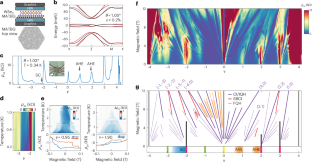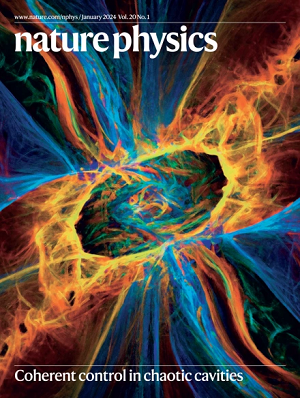Strongly interacting Hofstadter states in magic-angle twisted bilayer graphene
IF 18.4
1区 物理与天体物理
Q1 PHYSICS, MULTIDISCIPLINARY
引用次数: 0
Abstract
Magic-angle twisted bilayer graphene hosts a variety of strongly correlated states at partial fillings of its flat bands. In a magnetic field, these flat bands evolve into a Hofstadter spectrum renormalized by strong Coulomb interactions. Here we study the interacting Hofstadter states that spontaneously form within the topological magnetic sub-bands of an ultraclean magic-angle twisted bilayer graphene device, including symmetry-broken Chern insulator states and fractional quantum Hall states. The observed symmetry-broken Chern insulator states form a cascade, with their Chern numbers mimicking the main sequence of correlated Chern insulators. The fractional quantum Hall states form in a Jain sequence. However, they disappear at high magnetic field, in contrast to conventional fractional quantum Hall states that strengthen with increasing magnetic field. We reveal a magnetic-field-driven phase transition from composite fermion phases to a dissipative Fermi liquid. Our theoretical analysis of the magnetic sub-bands hosting the fractional quantum Hall states predicts non-uniform quantum geometric properties far from the lowest Landau level. This points towards a more natural interpretation of these states as in-field fractional Chern insulators of the magnetic sub-bands. Interacting electrons in Hofstadter bands can form symmetry-broken topological states. These are now revealed in magic-angle twisted bilayer graphene, and their properties are influenced by non-uniform quantum geometry.


魔角扭曲双层石墨烯中强相互作用的霍夫施塔特态
魔角扭曲双层石墨烯在其平面带的部分填充处具有多种强相关态。在磁场中,这些平坦带通过强库仑相互作用演变成霍夫施塔特谱。本文研究了在超净魔角扭曲双层石墨烯器件的拓扑磁子带内自发形成的相互作用的霍夫施塔特态,包括对称破缺陈氏绝缘体态和分数量子霍尔态。观察到的对称破缺陈氏绝缘子态形成级联,其陈氏数模仿相关陈氏绝缘子的主序列。分数量子霍尔态在耆那教序列中形成。然而,它们在高磁场下消失,而传统的分数量子霍尔态随着磁场的增加而增强。我们揭示了从复合费米子相到耗散费米液体的磁场驱动相变。我们对承载分数量子霍尔态的磁子带的理论分析预测了远离最低朗道能级的非均匀量子几何性质。这指向一个更自然的解释,这些状态作为磁场子带的场内分数陈氏绝缘体。
本文章由计算机程序翻译,如有差异,请以英文原文为准。
求助全文
约1分钟内获得全文
求助全文
来源期刊

Nature Physics
物理-物理:综合
CiteScore
30.40
自引率
2.00%
发文量
349
审稿时长
4-8 weeks
期刊介绍:
Nature Physics is dedicated to publishing top-tier original research in physics with a fair and rigorous review process. It provides high visibility and access to a broad readership, maintaining high standards in copy editing and production, ensuring rapid publication, and maintaining independence from academic societies and other vested interests.
The journal presents two main research paper formats: Letters and Articles. Alongside primary research, Nature Physics serves as a central source for valuable information within the physics community through Review Articles, News & Views, Research Highlights covering crucial developments across the physics literature, Commentaries, Book Reviews, and Correspondence.
 求助内容:
求助内容: 应助结果提醒方式:
应助结果提醒方式:


